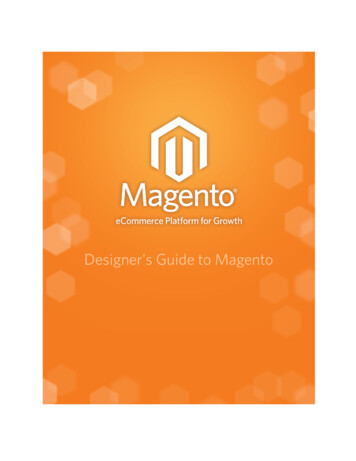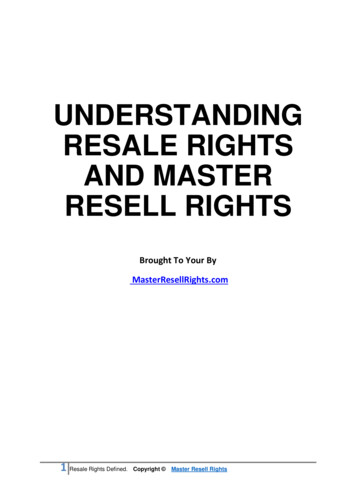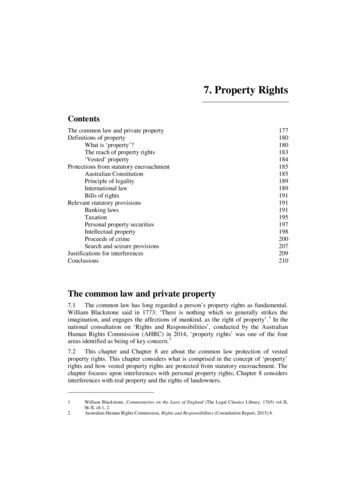
Transcription
Copyright 2011 Magento, Inc.All rights reserved. No part of this Guide shall be reproduced, stored in a retrieval system, ortransmitted by any means, electronic, mechanical, photocopying, recording, or otherwise,without written permission from Magento, Inc.
CONTENTS1 OVERVIEW OF THEMING IN MAGENTO .1SCOPE OF THIS DOCUMENT.1AUDIENCE .1PREREQUISITES.1ABOUT THIS GUIDE.12 MAGENTO DESIGN CONCEPTS AND TERMINOLOGY.3WEBSITES AND STORES.3DESIGN PACKAGES AND THEMES.5Themes.6Default themes .7Theme variations or non-Default themes.8Magento’s Theme Fallback Model .8BLOCKS AND LAYOUTS.10Blocks .10WIDGETS .12Widget Terminology .12Widget Examples.123 PACKAGES AND THEMES IN MAGENTO’S DIRECTORY STRUCTURE .15The Base package .15The Default, Pro and Enterprise Packages .16Custom Design Packages.18Themes.194 APPLYING THEMES IN MAGENTO .21WALKTHROUGH 1: CREATING AND APPLYING A THEME .21Assigning packages and themes to the store .21WALKTHROUGH 2: APPLYING MULTIPLE THEMES .23HIERARCHY OF THEMES .28Important Hierarchy Rules to Remember .31Design Exceptions.315 CUSTOMIZING MAGENTO THEMES .33CREATING THE DIRECTORY SKELETON FOR YOUR PACKAGE/THEME .33Designers Guide to Ma gentoiii
ContentsCreating a new Package and theme(s).33APPLYING YOUR NEW PACKAGE AND THEME TO YOUR WEBSITE.35Disable your system cache .35Apply Your Custom Package/theme to your Store.35CUSTOMIZING USING THE SKIN FILES .36Quick Exercises to Get You Started .36Exercise #1: Modify the CSS .36Exercise #2: Change the logo .36CUSTOMIZING USING LAYOUT FILES.37Introduction to Layouts.37How Magento Layout Works .40Anatomy of A Magento Layout File .42Handles .42 block .42 reference .43Rules of XML.44How to find which layout file to modify .44Quick Exercises to Get You Started .45Exercise #1 .45Exercise #2 .46Customizing Using a Local Layout file (local.xml).47CUSTOMIZING USING TEMPLATES .48Exercise #1 .496 QUICK GUIDE TO BUILDING A THEME FROM SCRATCH.51ONE: Disable your system cache .51TWO: Determine all the possibilities of structure types for your store .51THREE: Cut up your xHTML according to functionality .52FOUR: Change the layout to reflect your design .537 OTHER RESOURCES .55ivDesigners Guide to Ma gento
1 OVERVIEW OF THEM ING IN MAGENTOThe Designer's Guide to Magento expands your knowledge of the structural workings of Magento and themethods of designing for Magento. It teaches how to create a theme of your own with Magento. Due toMagento’s extreme flexibility, it is not possible to document all the different ways in which it can becustomized. For help with this, consult Magento's community forums and wiki, where you can profit fromthe knowledge of people with real design experience. Also, remember that Magento is a constantly evolvingapplication, therefore, this documentation may not faithfully reflect your version of Magento. However, theconcepts introduced to you will still be very helpful.SCOPE OF THIS DOCUMENTThis docume nt supports the following versions of Magento:CEv1.4 , PEv1.8 , EEv1.8 AUDIENCETo understand this manual and undertake the tasks and best practices it describes, you must be thoroughlyfamiliar with HTML and CSS.PREREQUISITESYou need a working Magento installation if you would like to try the ideas presented in this manual.ABOUT THIS GUIDEThis docume ntation contains chapters that can be skipped through back and forth to quickly access only theinformation you need most. However, because each chapter acts as a prelude to the next, we advise you toconsider the documentation in the order it was written.Designers Guide to Ma gento1
1 Overview of Theming in Magento2Designers Guide to Ma gento
2 MAGENTO DESIGN CONCEPTS AND TERMINOLOGYIn order to follow along with this document, it is important that you have a good grasp of the terminologyand concepts that underlie the frontend aspects of the Magento system. The terminology introduced in thischapter may well be new territory for you, so read through it thoroug hly. But most importantly, do not bediscouraged if you do not fully grasp the concepts immediately. This chapter merely introduces them to youall at once, and later chapters will expand on those simple definitions.WEBSITES AND STORESBecause Magento natively supports the creation and management of multiple stores in a single Magentoinstallation, Magento has a hierarchy of concepts that define the relationship between the individual storesin a Magento installation.In Magento, a website is a collection of stores, which themselves are collections of store views. Theselayers, although perhaps initially confusing, provide you with powerf ul flexibility when setting up onlinebusinesses in Magento.A website is made up of one or more stores which share the same customer information, orderinformation and shoppi ng cart.Stores are collections of store views and can be setup in a variety of ways. Their main function is toprovide a logical container that allows you to group related store views together in a website.Store Views are the actual store instances in Magento. Most stores will have a single store viewassociated with them. But a store can also have multiple store views, which are typically used fordifferent languages. Therefore, if you wanted to have a store displayed in English and Spanish, forexample, you could create the store once and create two different store views for that store.Figure 1. Hierarchy of websites, stores and store views in Magento.Designers Guide to Ma gento3
2 Magento Design Concepts and TerminologyThese are very broad terms that can be adapted to fit the unique needs of individual merchants. A fewscenarios to illustrate the different uses of websites, stores and store views follow.SC ENARIO 1—O NE STOR EA company named “Bongo’s Instruments” wants to create an online presence. Bongo has a single catalogand does not need to support multiple languages. This is the simplest scenario in which Bongo’s Instrumentsis the website, store, and store view.Figure 2. Single website, store and store view.SC ENARIO 2 —MULTIPLE R ELATED STO R ESA company named “Dubloo” creates an online presence with three separate clothing stores that each caterto a different price-level audience. Dubloo wants the ability for all three of its stores to share customer andorder information—meaning customers can create an account in any of the stores and it will be available tothem in the others as well. In this scenario, Dubloo would have one website and three stores under theironline presence. Because all of the stores support a single language, they each have only one store view.Figure 3. Single website with multiple stores.SC ENARIO 3—M ULTIPLE INDEPENDENT STOR ESA company named “My Laptops” wants an online presence with two separate stores that both sell laptopsbut at different prices and with different product selections in some categories. They also want to offer4Designers Guide to Ma gento
2 Magento Design Concepts and TerminologyEnglish and Spanish language options per store. Within each store they need to synchronize customer andorder information, but they do not need to share this information between the two stores. In this scenario,My Laptops would have two websites (which stops customer and order info from being shared with stores inthe other website), each with one store and two store views (one for English and one for Spanish).Figure 4. Multiple websites with multiple stores and store views.DESIGN PACKAGES AND THEMESIn looking at the hierarchy of websites, stores and store views in the previous section, you can see that asingle Magento installation can run many stores which may or may not share the same look and feel.To exactly control the look and feel of each store in your Magento installation, Magento allows you to createthemes. Related themes are grouped together in design packages. Each store in your Magento installationcan use its own theme, or they can all share a single theme, or some combination of both.A design package is a collection of related themes. If you have been working with Magento for a while,you might remember these being referred to as interfaces in earlier versions and earlier documentation.You can have any number of design packages installed, but there must always be at least one. Wheninstalled, Magento has a special package named the “base package.” There will also be another packagespecific to the Magento edition you have installed. In CE, this package is named “default;” in PE, thispackage is named “pro” and in EE, this package is named “enterprise.” To this you can add any numberof your own custom design packages.Themes inside of a design package contain the actual files that determine the visual output and frontendfunctionality of your store. Themes are covered in more detail in the next section, but briefly, Magentothemes contain templating information (layout files, template files, theme-specific translation files) andskinning information (CSS files, images, and theme-specific JavaScript files). A theme can belong to onlyone design package. By convention, each design package must contain a default theme. Additionally, adesign package can contain any number of variations on that default theme—called variously nondefault themes or theme variants.Designers Guide to Ma gento5
2 Magento Design Concepts and TerminologyBase packageDefaultthemeDesignpackage 1Designpackage 2DefaultthemeDefaultthemeThemevariation 1Themevariation 2Figure 5. Relationship between design packages and themes in Magento.Both a design package and theme can be assigned on either the website level and/or store view levelthrough the Magento Admin Panel. If you assign a package in the website level, all your stores in thatwebsite will inherit the package of your website. You can further assign a package at the store and/or thestore view level, effectively overriding that of the website.THEMESA Magento theme is comprised of templating files (layout, template, locale) and/or skin files (CSS, images,theme-specific JavaScript) that create the visual experience of your store. These files reside in two maindirectories in your Magento file system: “App/design” directory – Files that control how the page templates are rendered “Skin” directory – Files that control the visual aspects of the theme—CSS, images, etcMagento breaks its theme files into separate directories like this to allow you more control over the securitylevel of each directory on your server. The files in the skin directory need to be accessible to web browsersand need a very open permission setting. The files in the app/design directory only need to be accessible tothe app and can be locked down furthe r.Inside of each of these directories, the files in a theme are broken down into further subdirectories by type leFigure 6. File types associated with Magento themes and their locations6Designers Guide to Ma gento
2 Magento Design Concepts and TerminologyBelow is a little more explanation of each directory and the types of files it contains.Templating files in the app/design/frontend/ designPackageName / themeName / directory are organizedinto the following subdirectories: Layout—Contains the basic XML files that define block structure for different pages as well ascontrol meta information and page encoding. Template—Contains the PHTML files that contain xHTML markups and any necessary PHP to createlogic for visual presentation. Some templates are page templates and some are block templates. Locale—Contains simple CSV text documents organized on a per language basis containingtranslation strings (as name-value pairs) for all text produced by Magento (e.g., for interfaceelements and messages, not products and categories)Skin files in the skin/frontend/ designPackageName / themeName / directory are organized into thefollowing subdirectories: CSS—Contains the CSS files used to control visual styling of the website Images—Contains all images used by the theme JS—Contains theme-specific JavaScript routines and callable functions. (Most JavaScript libraries,which might be shared across themes) are placed in the js/ directory at the Magento rootDEFAULT THEMESEvery design package must include a theme named ”default” which is the main theme for that package.When you assign a package to your store, unless you also specify a specific theme, Magento automaticallylooks for the theme named ”default” in that package’s directory and uses it to generate the frontend.Base packageDefaultthemeDesignpackage 1Designpackage 2DefaultthemeDefaultthemeThemevariation 1Themevariation 2Figure 7. Design packages must have a default theme.The default theme must contain all the required layouts, templates and skins to render your store. For anyrequired files that are not found in the default theme of a custom package, Magneto will look last in the basepackage’s default theme.Designers Guide to Ma gento7
2 Magento Design Concepts and TerminologyTHEME VARIATIONS OR NON-DEFAULT THEMESA theme variation can contain as many or as few theme files as you see fit for your need. Theme variationsallow you to easily create minor variations to your default theme that can be applied to your entire store,subsections of your store, specific pages in your store, or to a separate but related store. When working witha custom design package, you can either modify the default theme for that package or create another themein that design package in addition and load it alongside the default.Base packageDefaultthemeDesignpackage 1Designpackage 2DefaultthemeDefaultthemeThemevariation 1Themevariation 2Figure 8. Theme variations or non-default themes in a design package.Examples might include: A replacement parts section of your website that requires a less media-rich product page A section of your website that previews next season’s products but does not yet offer them for sale A seasonal creative change that you want to apply to your entire website, but only for a limited time A branded website for another division of your busi ness that needs the same overall branding as theparent site, but requires other modifications based on their catalog and business processes.MAGENTO’S THEME FALLBACK MODELMagento’s theme architecture was changed between Community Edition (CE) v1.3 and CE v1.4 and betweenEnterprise Edition (EE) v1.7 and EE v1.8 to make custom themes easier to maintain and more “upgradeproof.” In these releases the theme files were also refactored and changed considerably to improveperformance and accessibility, but the biggest change was to the overall theme structure and hierarchy usedby Magento.Magento has always used fallback logic in rendering themes, but with CE v1.4 and EE v1.8, this has beenexpanded to include the base package as the final cross-package fallback point. In previous Magentoversions, fallback was only inside of a theme and customized frontend functionality could not be sharedbetween packages without replicating all of the files to each package.8Designers Guide to Ma gento
2 Magento Design Concepts and TerminologyAn example of how Magento’s fallback logic works is, if your custom theme calls for a CSS file named”styles.css,” but the Magento application is unable to find the file in your custom theme, Magento willsearch the next theme in the hierarchy for the file and continue searching the hierarchy of themes until itlocates the file named ”styles.css.“ This method of building design is called “fallback” because theapplication ”falls back” to the next possible source of required files in order to retrieve and load a requestedfile.The fall-back hierarchy in Magento CE v1.4 and EE v1.8 is shown in the diagram below.Figure 9. Logical flow of Magento’s theme fallback model.When used effectively, this fallback mechanism allows you to edit and maintain only the files you need tochange as a custom theme and all of the other functionality is provided by either the custom package defaulttheme or the base package.For example, Magento maintains 4 CE demo themes—default, blank, modern, and iPhone. Before theintroduction of the base package, all theme files had to be copied to each package and maintained, testedand debugged in each. With the introduction of the base package, we maintain three times less code. Forexample, the default/default and default/blank themes are implemented with just CSS changes and get alltemplate and layout files from the base package.Ultimately, this also makes your custom themes more “upgrade proof” and allows you to maintain less codeas well. Most custom themes only customize a subset of the default Magento functionality, therefore, now allof the core functionality will be made available by the base package and can be overridden selectively by acustom package/theme.Designers Guide to Ma gento9
2 Magento Design Concepts and TerminologyBLOCKS AND LAYOUTSThere are some concepts and tools you need to learn to be a successful designer in Magento: Structural Blocks Content Blocks LayoutBLOCKSBlocks are a way by which Magento distinguishes the array of functionalities in the system and creates amodular way to manage it from both visual and functional standpoint. There are two types of blocks andthey work together to create the visual output.Structural Blocks—These are blocks created for the sole purpose of assigning visual structure to a store pagesuch as header, left column, main column and footer.Content Blocks—These are blocks that produce the actual content inside each structural block. They arerepresentations of each feature’s functionality in a page and employ template files to generate xHTML to beinserted into its parent structural block. Category list, mini cart, product tags and product listing, etc, areeach its own content block. Instead of including template after template as a typical eCommerce applicationwould in order to gather the entire xHTML output, Magento gathers and arranges page content throughblocks.Layouts—These are the files that essentially map your content blocks to your structural blocks. Layouts inMagento have two functions—they define both the structural and content blocks and then they informMagento how and where to connect them up.10Designers Guide to Ma gento
2 Magento Design Concepts and TerminologyFigure 10. An example of structural blocksFigure 11. An example of content blocks mapped to specific structural blocksDesigners Guide to Ma gento11
2 Magento Design Concepts and TerminologyWIDGETSYou may be familiar with the term “widgets” from other online applications. In Magento, widgets arefrontend blocks with a predefined set of configuration options. These configuration options are displayed ina special edit form in the backend panel when a widget is being added or edited by a store owner. Theability to easily set widget configuration options allows for the full control of widget placement on a page tostore owners. An important aspect of widgets is that using them eliminates some of the theme-levelcustomization that used to be required when setting up a Magento store.Essentially, they are a great way to allow business users with no technical knowledge to easily add dynamiccontent (including product data, for example), in areas predefined by the designer/developer, to pages inMagento Stores. This allows for greater control and flexibility in creating informational and marketingcontent through administrator tools, enabling intuitive and efficient control of content such as: Dynamic product data in marketing campaign landing pages Dynamic Information such as recently viewed items in content pages Promotional images to position in different blocks, side columns and other locations throughout thestorefront Interactive elements and action blocks (external review systems, video chats, voting andsubscription forms) Alternative navigation elements (tag clouds, catalog image sliders) Interactive and dynamic Flash elements easily configured and embedded within content pages forenhanced user experienceWIDGET TERMINOLOGY Frontend Block – an element which creates the visual output either by assigning visual structure orby producing the actual content. Magento Widget – a frontend block that implements a special widget interface which allows forhaving different configuration options per each block instance, and the ability to have multipleindependent block instances on pages. Magento Widget Instance – a block on a single page or multiple pages which receives itsconfiguration options as defined by a store owner in the backend. The same widget can be added tothe frontend multiple times producing multiple instances of the same widget.Please note that a single widget instance can also be added to multiple pages (with the sameconfiguration options values) and managed as a single entity.WIDGET EXAMPLESMagento includes the following default configurable widgets; new widgets can be created by developers aswell. 12CMS Page Link – displays a link to a selected CMS Page, and allows specifying custom text and title.Two templates are available for this widget – inline link and block template.Designers Guide to Ma gento
2 Magento Design Concepts and Terminology CMS Static Block – displays content of a selected static block. Catalog Category Link – displays a link to a selected catalog category, and allows specifying customtext and title. Two templates (inline and block) are available. Catalog Product Link – displays a link to a selected catalog product, and allows specifying customtext and title. Two templates (inline and block) are available. Recently Compared Produc ts - displays a block which contains recently compared products. ThisWidget allows for specifying the number of products to be displayed and has two templatesavailable (product list or product grid view). Recently Viewed Produc ts - displays a block which contains recently viewed products. This Widgetallows for specifying the number of products to be displayed and has two templates available(product list or product grid view).Designers Guide to Ma gento13
2 Magento Design Concepts and Terminology14Designers Guide to Ma gento
3 PACKAGES AND THEMES IN MAGENTO’S DIRECTORY S TRUCT UREThemes are grouped together logically into design packages, but, as described n the previous chapter, thetheme files are physically split between two directories. This can be a little confusing when you are firststarting out with Magento theming, so this chapter shows you the directory structure associated with each ofthe main design packages and themes used in Magento.As you go through this section, notice that directory names for the design packages and themes must be thesame in both the app/design and skin directory. Notice also that below that level in each directory, Magentohas a set of required directories in which your templating and skin files defaultpro tmodernetc.iphoneFigure 12. Package types and themes in MagentoTHE BASE PACKAGEThe base package was introduced in CE v1.4 and EE v1.8. The role of the base package is to provide hooksto all of Magento’s core functionality, so that your custom themes can include in them just the changes tothat functionality that are specific to the design or business they are intended to support. Magento does thisby using the “fallback” model in which it looks for the files it needs in order to render a page first in yourcustom design package and then in the base package if it does not find them.Note: The base package is the final fallback point for all of your design packages and should never be editedor modified when you create and customize your own themesThis provides a cleaner codebase and a better upgrade path for your themes because the base package willcontain all of the files that control Magento’s default behavior (and there are a lot of them), but your customtheme only needs to contain the files that you have changed or that you have used to override the defaultbeh
1 OVERVIEW OF THEMING IN MAGENTO The Designer's Guide to Magento expands your knowledge of the structural workings of Magento and the methods of designing for Magento. It teaches how to create a theme of your own with Magento. ue to D Magento's extreme flexibility, it is not possible to document all the different ways in which it can be











